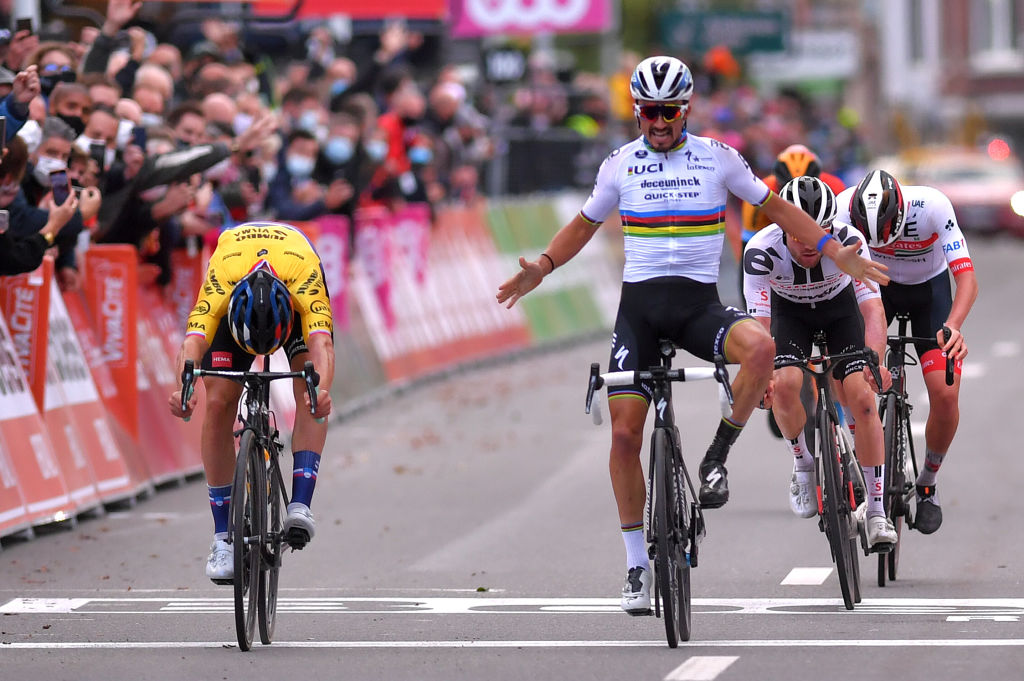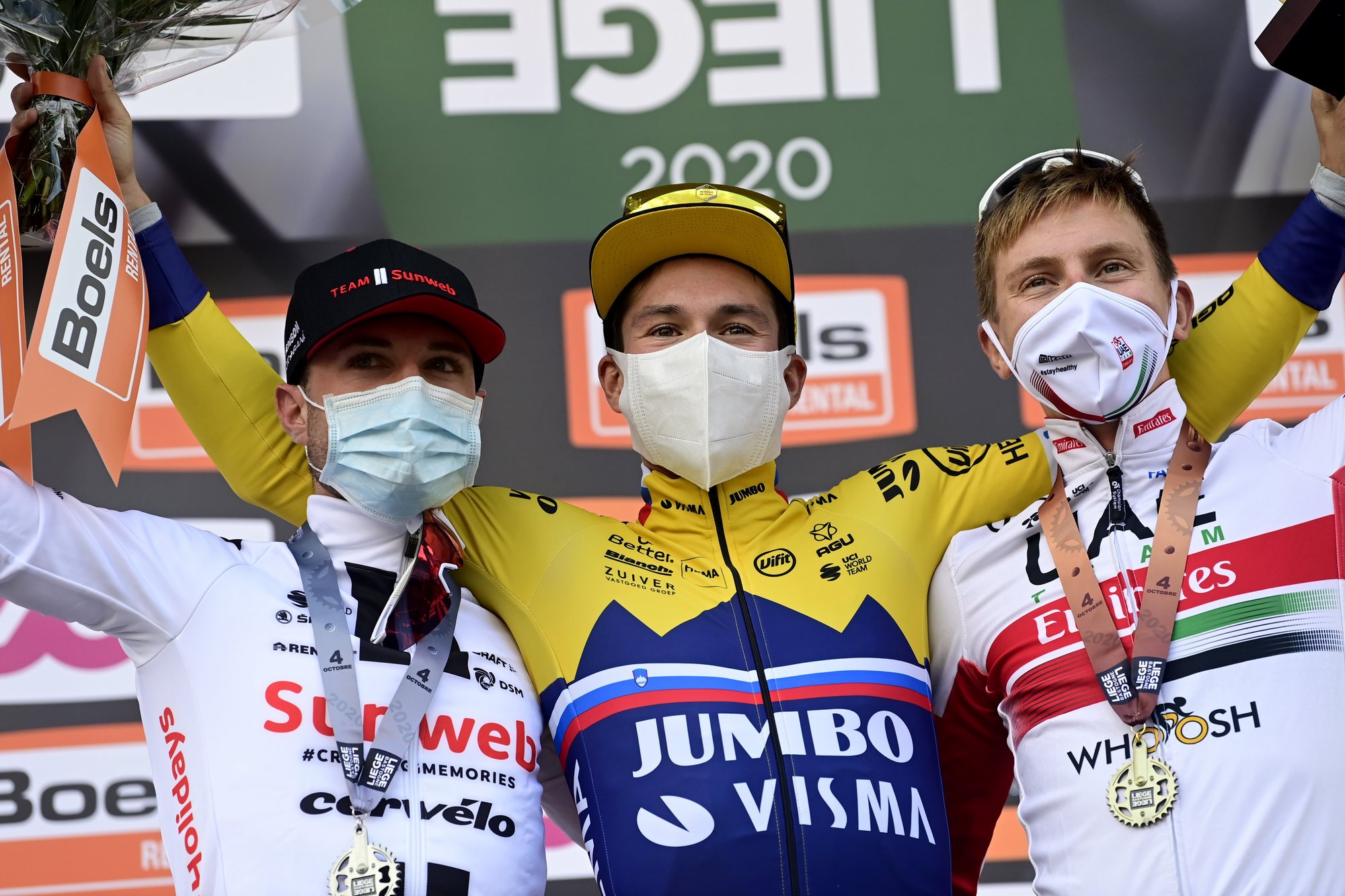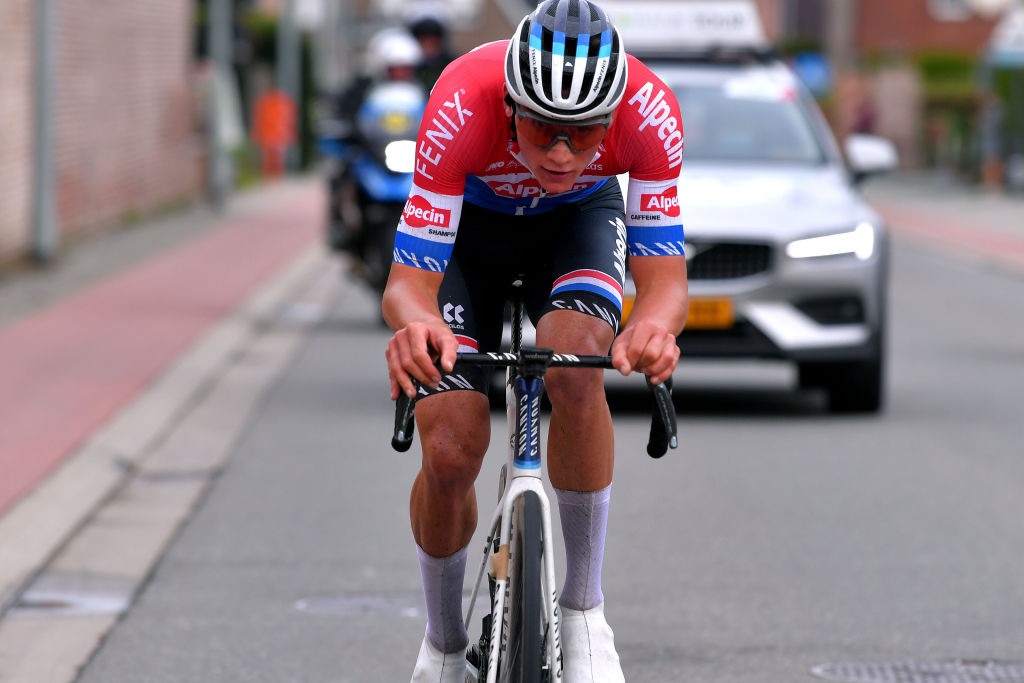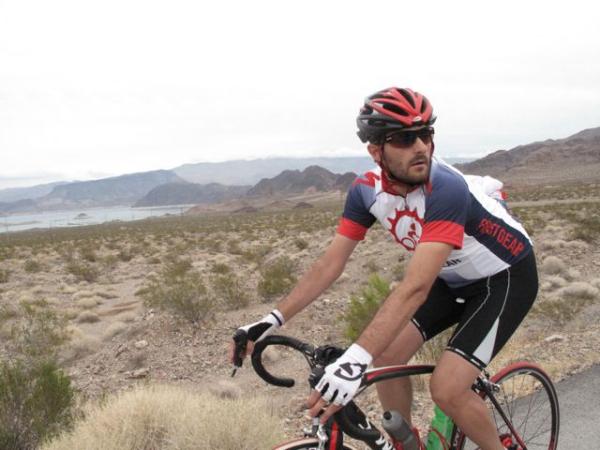6 conclusions from the men’s Liège-Bastogne-Liège
Alaphilippe’s rainbow disaster, Roglic’s deserved Monument and more questions about race safety

Sunday’s Liège-Bastogne-Liège will be remembered for Julian Alaphilippe’s premature victory salute in the rainbow jersey and his subsequent relegation for changing his line in the sprint.
However, Alaphilippe’s misdemeanors should not overshadow Primož Roglič’s victory. The quiet spoken Slovenian appears to have overcome his surprise defeat at the Tour de France and was strong and determined in the Ardennes.
In an ominous sign for the rapidly approaching cobbled Classics, Mathieu van der Poel also looked on form, finishing sixth and best of the chasers, just 24 hours after an aggressive ride to win the BinckBank Tour.
Sadly, Greg van Avermaet is unlikely to contest the cobbled Classics after crashing into an unmarked and unprotected signpost in the middle of the road. It is yet another example to ask who is fined for safety negligence at races
Here we take a look at the six big conclusions from the oldest classics on the men’s calendar.
In praise of Primož Roglič’s resolve
Most riders would have struggled to even look at a bike, let alone race one, had they been through what Primož Roglič had been forced to endure these past few weeks.
First came the crushing manner in which he was painfully beaten in the Tour de France and the gut-wrenching way he had to watch as Tadej Pogačar almost effortlessly stole second after second from him at La Planche des Belles Filles. If that wasn’t enough, when Roglič returned to racing just a week later and put aside that crushing defeat to work alongside Pogačar and take sixth in Worlds he crossed the line to a chorus of social media hate from a small but loud and uneducated group who questioned why he had the temerity to not work for a rider from another nation.
Get The Leadout Newsletter
The latest race content, interviews, features, reviews and expert buying guides, direct to your inbox!
At that point, most riders would have tossed their phone into the Imola hillside and hibernated for what was left of the season. Not Roglič. Whether you’re a fan of him or his meteoric rise, one has to acknowledge that the Slovenian has acted with a degree of grace and humility in recent weeks and has shown incredible resolve. It’s that final quality – added to Julian Alphalippe’s complacency – that earned Roglič a well-deserved victory at Liège-Bastogne-Liège.
A Monument win
While the botched sprint from the Frenchman hogs the limelight, one of the most telling moments of the race came on the final climb when Roglič rode up to Tom Dumoulin - the pair were midway up the leading group – and the two teammates exchanged looks.
Dumoulin went to the front, ripped the race apart with a searing injection of pace, and the race played out accordingly. There was still a huge amount for Roglič to do, however. First, he had to latch onto Alaphilippe’s attack; then he had to chase again when the Frenchman and Marc Hirschi clipped off the front on the final unclassified rise; then he had to keep his cool while some around him – Alaphilippe again – were losing theirs – before finally showing grit to keep on sprinting to the line.
There was some luck in that Alaphilippe’s manoeuver took out Hirschi and Pogačar but who would begrudge Roglič any of that after the last few weeks.

The thin line between Alaphilippe’s confidence and cockiness
There’s a thin line between confidence and cockiness but on Sunday the new world champion veered well towards the latter with a display that ended in embarrassment just when destiny was calling.
He was strong enough to win, there’s no doubt, and how he bounced back from a crash and several equipment changes deserves credit but his antics in the final kilometre were highly questionable.
He almost took himself and several others down leading into the final corner before the finish because he wasn’t looking where he was going, and then his switch of line not only hampered Hirschi but it also ruined any hope of Pogačar winning.
Alaphilippe can have no complaints with his relegation to fifth place and he made the right decision to apologize.
Before his error, it looked as though he had the race sewn up. Even after the mistake leading into the first corner he made the tactically astute decision to allow Mohoric to make contact, knowing full well that the Slovenian would make a telegraphed attack and lead out the sprint.
From that point everything unraveled for Alaphilippe: from starting his sprint too early, to switching lines and to then being beaten by his own sheer complacency.
Some will argue that his relegation saved his blushes but the image of the World champion celebrating too soon will be the lasting memory of this race, not his relegation.
Van der Poel doubles up
The Dutchman was relatively quiet by his standard when racing resumed in August but he’s making up for that now with some scintillating performances, and if the trend continues he will take some stopping in the cobbled Classics.
After his unbelievable exploits on the final day of BinckBank came his ride on Sunday even if the return of sixth place barely reflected his ride in Liege.
He wasn’t strong enough to go with the very best on the final climb but the manner in which he almost single-handedly led the chase and then had enough energy in the tank to take sixth means that Gent-Wevelgem, the Tour of Flanders, and Paris-Roubaix are all winnable.
Those suggesting that his team isn’t strong enough to support such a bid will do well to remember that he won Amstel Gold, that he came close to a cobbled classic in 2019 with a weaker squad, and that three of his teammates finished inside the top 40 on Sunday. Ben Tulett, who only turned 19 a few weeks ago, finished just outside the top-50 and so became the youngest finisher since Victor Fastre won La Doyenne back in 1909.

Who is fined for safety negligence?
A certain team – and let’s not mention them by name because they’ve already gained enough publicity for breaking protocols with their Giro jersey, were rightly punished by the UCI for their actions.
Just because jersey design registration is a minor rule, doesn’t mean it shouldn’t be respected. Yet while the UCI are quick to fill their coffers at the easiest opportunity, where were they with their fines and rulings when Greg Van Avermaet was taken down by a piece of un-marshaled and unprotected piece of road furniture?
Crashes will happen and race organisers, in this case ASO, cannot be expected to fill every pothole or cover every slippery patch such as the one that took out Michael Valgren and Damiano Caruso. But surely more should be expected when it comes to metal poles sticking out of the ground in the middle of the road.
Imagine if Van Avermaet hadn’t signed with AG2R La Mondiale for 2021, was instead still hoping that the CCC board would pull a rabbit out of a hat, and that a winning ride in the Classics was all that was needed to persuade some conglomerate to sign on the dotted line.
It sounds fanciful, perhaps, but that’s often how sponsors are attracted and they’re certainly not brought to the table when riders are sitting on the sidelines because a race organizer got sloppy and a crash cost a rider his Classics season.
This is a bigger issue that is about more than just Van Avermaet and one road sign. Where were the CPA and the UCI in publicly questioning road safety at Liège-Bastogne-Liège?
The answer, unfortunately, is that both parties are still tone-deaf to such issues.
Out of Teuns
After Dylan Teuns signed a contract extension at Bahrain McLaren earlier in the year it looked as though the Belgian was on the cusp of another great season.
However, a poor showing at the Dauphine, followed along with his public dismay at missing out on the Tour de France means he was not competitive at Liège-Bastogne-Liège.
He had a good case for his inclusion given that he won the team’s first stage twelve months ago and that despite his form he still offered something no one else on the team had.
While leaving him at home for the race now looks like the right call, the 28-year-old is still nowhere near his peak condition. He was quiet in Tirreno-Adriatico and then followed that with meek rides in both Flèche Wallonne and Liege-Bastogne-Liege.
There were injury issues earlier in the campaign, so there are some mitigating circumstances but 2020 is very quickly slipping through Teuns’ fingers and despite a purple patch of form between February and March he needs to salvage his year with something in the next few weeks.
Daniel Benson was the Editor in Chief at Cyclingnews.com between 2008 and 2022. Based in the UK, he joined the Cyclingnews team in 2008 as the site's first UK-based Managing Editor. In that time, he reported on over a dozen editions of the Tour de France, several World Championships, the Tour Down Under, Spring Classics, and the London 2012 Olympic Games. With the help of the excellent editorial team, he ran the coverage on Cyclingnews and has interviewed leading figures in the sport including UCI Presidents and Tour de France winners.
